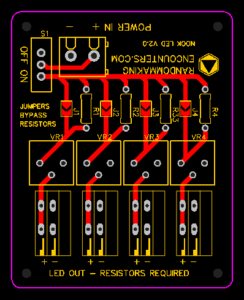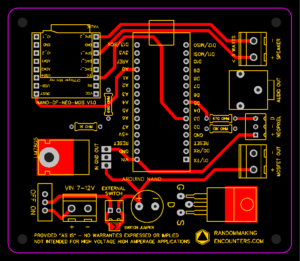While it’s very possible to assemble a pretty reasonable circuit with proto-boards or even go all-out and etch a one-off, I found that I kept needing the same things over and over. For my book nooks, I needed a quick way to wire up a strand of NeoPixels to an Arduino Nano while leaving a few pins open for some LEDs or other goodies. That led me down the path of designing and ordering a few of my own custom boards. While it seemed a bit daunting at first, it turns out there are some pretty nifty tools and manufacturers that make the process reasonably easy.
Online editors and circuit board manufacturing
I am not affiliated with either of these sites and have not received any envelopes stuffed with cash. I have used both the design tool and ordered boards and have been very happy with the results. Pricing seems fair with the only downside that I paid as much for shipping as I did the boards themselves. This approach really makes sense when you want to order a handful and probably not just a one-off.
EASYEDA.COM – I’ve used other design software in the past—Eagle comes to mind. They all have their quirks and take a bit of getting used to… especially if you’re not a PCB expert or electrical engineer. However, for some basic board building, it was reasonably easy to muddle through and the integration with JLCPCB made the process of going from design to final board pretty seamless.
JLCPCB.COM – With a click you can go from your design straight to the ordering process. There are a lot of variables that go into the final price so I would recommend visiting the site for the latest and greatest numbers. At the time I type this, a 100mm square, two layer board is $2.00 plus $20 shipping for five—see what I mean! However, the math still works out to around $4.00 a board… not terrible.
My current creations
I started out with a board that would allow me to connect four LEDs to a power source and use both inline and variable resistors. From there, things progressed until my most ambitious board allows me to control a DFPlayer Mini and either a string of LEDs through a power MOSFET or a strand of NeoPixels. I am no circuit board design expert and I’m sure the experts out there will find these designs cringe-worthy at best. Honestly, the last board I’ve barely tested to make sure it even works… in theory… it kinda should??
LEDs with variable resistors
Probably the simplest of the lot! The goal of this one was to be able to control the brightness of up to four LEDs with variable resistors. The static resistors should have values that protect the LEDs with the variable resistors providing the additional resistance needed to dim. I put in jumpers to bypass the static resistors if needed. The effectiveness of this really depends on the range of the variable resistors. An on/off switch rounds out the board.

Arduino Nano, NeoPixels, DFPlayer Mini, and MOSFET
Following up on the sound board, the question came up, “What if I want to power/control something a bit more than NeoPixels?” So! Last but not least, I plopped in a MOSFET so I could toggle on something like a regular strand of LEDs or maybe a small motor? This requires a bit more voltage and some voltage regulation. The big concern I have here is with heat dissipation on the MOSFET and current capacity of the traces. I would never exceed 12 volts and 2 amps on this board. This one is very much in the Alpha stage.

So I see there are Gerber files!
Your eyes are not deceiving you. There are links to downloads of the Gerber files for each board. These are provided as is and you can do anything you want with them at your own risk. All of the caveats and disclaimers of my general “I have no idea what I’m really doing” approach apply. These are in no way, shape, or form professionally designed no matter how cool they look. They could work flawlessly or burst into flames for no reason other than it being the third Tuesday of the month… or a bad solder connection. I create these boards for my personal use and have no desire to burn down my house so I make every effort to make sure the things I make are reasonably safe—that doesn’t guarantee they are.
None of these boards should ever be used for high voltage or high amperage applications… never ever.
With all of that being said, be careful, use your best judgement, and have fun!
